Mercedes-Benz A-CLASS SEDAN 2021 Emergency User Manual
Introduction
Welcome to the Mercedes-Benz A-Class Sedan 2021, a world of refinement, power, and safety where luxury meets utility and innovation reigns supreme. This amazing car, built to manage any emergency with steadfast serenity, emerges as your ultimate ally in situations of unpredictability and unexpected twists on the road.
The Mercedes-Benz A-Class Sedan 2021 is crafted with precision and elegance and flawlessly combines legendary design elements with cutting-edge technology, setting new benchmarks for the automotive industry. The vehicle’s iconic diamond grille, slender lines, and dynamic LED lighting are just a few of the features that showcase the brand’s dedication to superior engineering and classic design. The A-Class Sedan 2021 is designed to function flawlessly under duress in addition to its outstanding look. sophisticated safety features, such as collision prevention systems, intelligent driver support systems,
Emergency
Removing the safety vest
The safety vests are located in the storage compartments in the drivers and front passenger door.
- To remove: pull out the safety vest bag by the loop.
- Open the safety vest bag and pull out the safety vest.
- There are also safety vest compartments in the rear door storage compartments in which safety vests can be stored.
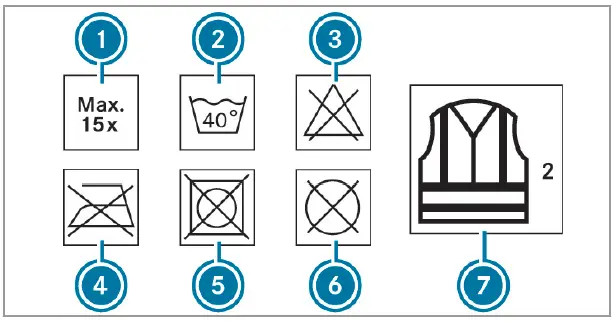
- Maximum number of washes
- Maximum wash temperature
- Do not bleach
- Do not iron
- Do not tumble dry
- Do not dry clean
- Class 2 safety vest
The requirements defined by the legal standard are only fulfilled if the safety vest is the correct size and is fully closed.
Replace the safety vest in the following cases:
- The reflective strips are damaged or dirty
- The maximum permissible number of washes is exceeded
- The fluorescence has faded
Removing the warning triangle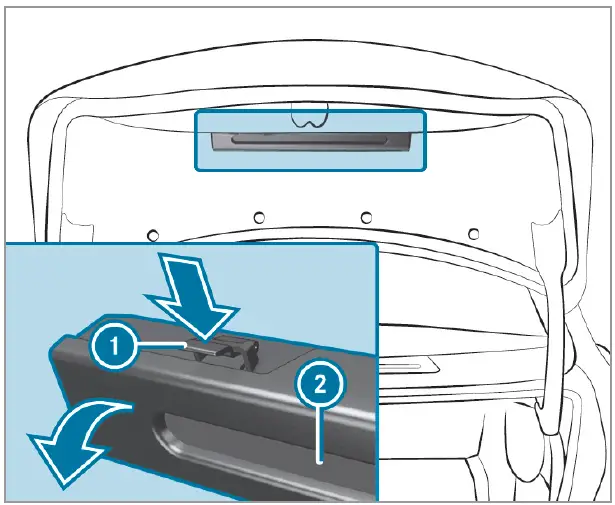
- Push both sides of warning triangle holder 1 in the direction of the arrow and open it.
- Remove warning triangle 2.
Setting up the warning triangle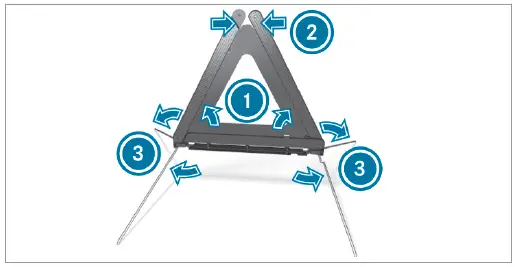
- Fold side reflectors 1 upwards to form a triangle and attach at the top using upper press-stud 2.
- Fold legs 3 down and out to the side.
First-aid kit (soft-sided) overview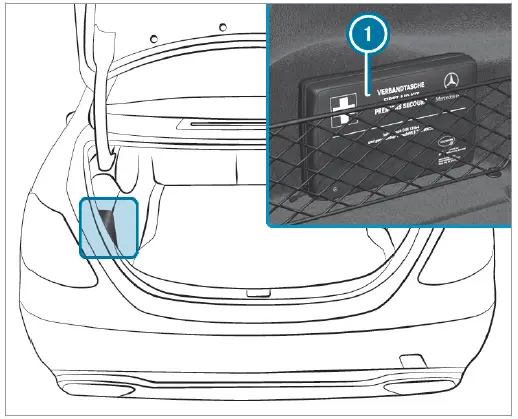
First-aid kit (soft sided) 1 is in the trunk in the left-hand or right-hand storage net, depending on the model.
Depending on the vehicle’s equipment, the first-aid kit (soft-sided) is in the recess in the side trim.
Flat tire
Notes in the event of a flat tire
WARNING
Risk of accident due to a flat tire
A flat tire severely affects the driving charac‐teristics as well as the steering and braking of the vehicle.
Tires without run-flat characteristics:
- Do not drive with a flat tire.
- Change the flat tire immediately with an emergency spare wheel or spare wheel. Alternatively, consult a qualified spe‐cialist workshop.
Tires with run-flat characteristics:
- Observe the information and warning notes on MOExtended tires (run-flat tire).
In the event of a flat tire, the following options are available depending on your vehicle’s equip‐ment:
- Vehicles with MOExtended tires: it is possible to continue the journey for a short period of time. Make sure you observe the notes on MOExtended tires (run-flat tires).
- Vehicles with a TIREFIT kit: you can repair the tire so that it is possible to continue the journey for a short period of time. To do this, use the TIREFIT kit.
- Vehicles with Mercedes me connect: you can make a call for breakdown assistance via the overhead control panel in the case of a breakdown.
- All vehicles: change the wheel.
- The emergency spare wheel is only available in certain countries.
Notes on MOExtended tires (run-flat tires)
WARNING
Risk of accident when driving in limp-home mode
When driving in emergency mode the han‐dling characteristics are impaired.
- Do not exceed the specified maximum speed of the MOExtended tires.
- Avoid any abrupt steering and driving maneuvers as well as driving over obstacles (curbs, pot holes, off-road). This applies, in particular, to a loaded vehicle.
- Stop driving in the emergency mode if you notice:
- Banging noise
- Vehicle vibration
- Smoke which smells like rubber
- Continuous ESP® intervention
- Cracks in the tire side walls
- After driving in emergency mode, have the rims checked by a qualified specialist workshop with regard to their further use.
- The defective tire must be replaced in every case.
With MOExtended tires (run-flat tires), you can continue to drive your vehicle even if there is a total loss of pressure in one or more tires. How‐ever, the tire affected must not show any clearly visible damage.
You can recognize MOExtended tires by the MOExtended marking which appears on the side wall of the tire.
Vehicles with tire pressure loss warning sys‐tem:
MOExtended tires may only be used in con‐junction with an activated tire pressure loss warning system.
Vehicles with tire pressure monitoring sys‐tem:
MOExtended tires may only be used in con‐junction with an activated tire pressure monitor‐ing system.
If a pressure loss warning message appears in the multifunction display, proceed as follows:
- Check the tires for damage.
- If driving on, observe the following notes.
Driving distance possible in emergency mode after the pressure loss warning:
| Load condition | Driving distance pos‐ sible in emergency mode |
| Partially laden | 50 miles (80 km) |
| Fully laden | 19 miles (30 km) |
The driving distance possible in emergency mode may vary depending on the driving style. Observe the maximum permissible speed of 50 mph (80 km/h).
If a tire has gone flat and cannot be replaced with a MOExtended tire, you can use a standard tire as a temporary measure.
TIREFIT kit storage location
The TIREFIT kit is located under the trunk floor.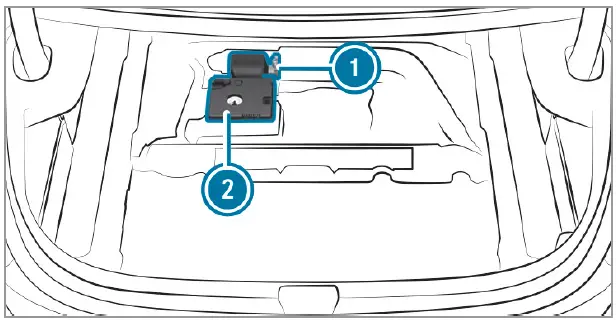
- Tire sealant bottle
- Tire inflation compressor
Depending on the model, the TIREFIT kit may also be located in other places under the trunk floor.
Using the TIREFIT kit
Required tools:
- Tire sealant bottle
- TIREFIT sticker
- Sticker with details of the maximum permissible speed
- Tire inflation compressor
- Gloves
TIREFIT kit storage location:
You can use TIREFIT tire sealant to seal perforation damage of up to 0.16 in (4 mm), particularly those in the tire contact surface. You can use TIREFIT in outside temperatures down to -4 °F (-20 °C).
WARNING
Risk of accident when using tire sealant
The tire sealant may be unable to seal the tire properly, especially in the following cases:
- There are cuts or punctures in the tire larger than damage previously mentioned.
- The wheel rim is damaged.
- You have driven at very low tire pressure or on a flat tire.
- Do not continue driving.
- Consult a qualified specialist workshop.
The tire sealant is harmful and causes irritation. Do not allow it to come into contact with the skin, eyes or clothing, and do not swallow it. Do not inhale tire sealant fumes. Keep the tire sealant away from children.
If you come into contact with the tire sealant, observe the following:
- Rinse off the tire sealant from your skin immediately using water.
- If tire sealant gets into your eyes, thoroughly rinse out the eyes using clean water.
- If tire sealant has been swallowed, immediately rinse out the mouth thoroughly and drink plenty of water. Do not induce vomiting and seek medical attention immediately.
- Change out of any clothes contaminated with tire sealant immediately.
- If allergic reactions occur, seek medical attention immediately.
NOTE Overheating due to the tire infla‐tion compressor running too long - Do not run the tire inflation compressor for longer than ten minutes without interruption.
Comply with the manufacturer’s safety notes on the sticker on the tire sealant bottle.
Have the tire sealant bottle replaced in a quali‐fied specialist workshop every five years.
- Do not remove any foreign objects which have entered the tire.
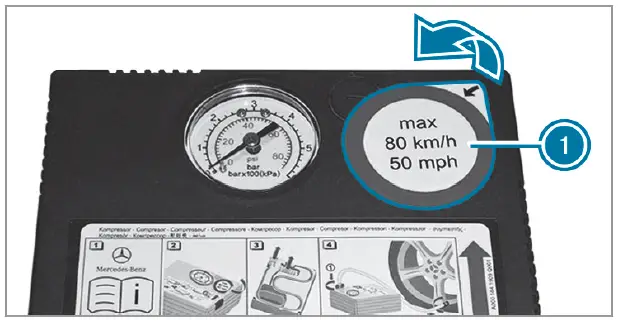
- Remove sticker 1 from the tire inflation compressor housing and affix it to the instru‐ment cluster within the driver’s field of vision.
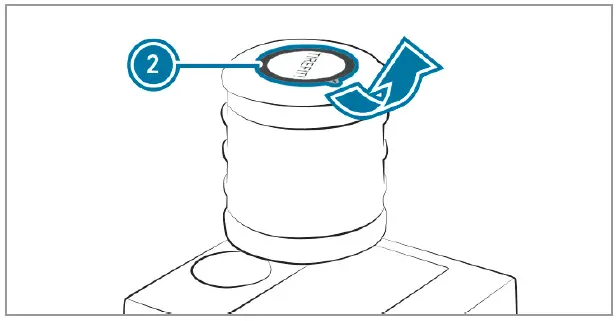
- Remove sticker 2 from the tire sealant bottle and affix it near the valve on the wheel with the faulty tire.
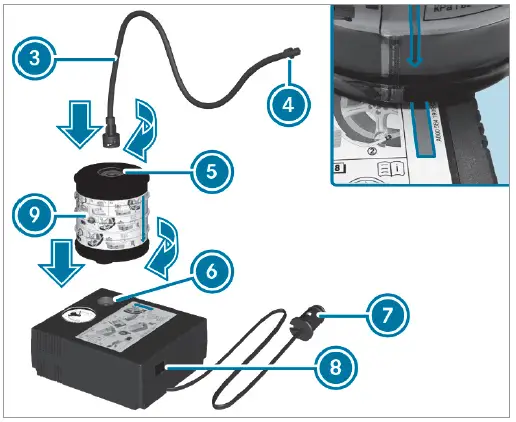
- Pull plug 7 with the cable and filler hose 3 out of the tire inflation compressor housing.
- Insert tire sealant bottle 9 in socket 6 of the tire inflation compressor in such a way that the red arrow on tire sealant bottle 9 matches the red arrow on the tire inflation compressor.
- Turn tire sealant bottle 9 a quarter turn clockwise.
- Insert the plug of filler hose 3 in socket 5 of tire sealant bottle 9.
- Turn filler hose 3 a quarter turn clockwise.
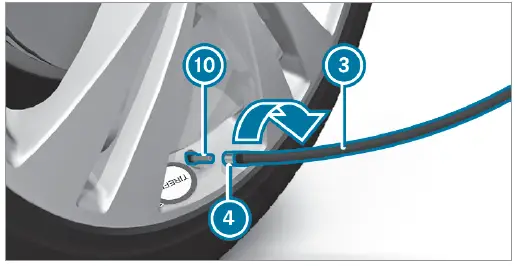
- Remove the valve cap from valve A on the faulty tire.
- Screw union nut 4 of filler hose 3 onto valve A.
- Insert plug 7 into a 12 V socket in your vehicle.
- Turn the SmartKey to position 1 in the igni‐tion lock.
- Press on and off switch 8 on the tire infla‐tion compressor.
The tire inflation compressor is switched on. The tire is inflated. First, tire sealant is pum‐ped into the tire. The pressure may briefly rise to approximately 500 kPa (5 bar/73 psi).
Do not switch off the tire inflation compres‐sor during this phase!
Let the tire inflation compressor run for a maximum of ten minutes.
The tire should then have attained a tire pressure of at least 200 kPa (2.0 bar/ 29 psi). If tire sealant leaks out, make sure you clean the affected area as quickly as possible. It is preferable to use clean water.
If you get tire sealant on your clothing, have it cleaned as soon as possible with perchloroethylene?
If, after ten minutes, a tire pressure of 200 kPa (2.0 bar/29 psi) has not been attained:
- Switch off the tire inflation compressor.
- Unscrew the filling hose from the valve of the faulty tire.
Please note that tire sealant may leak out when unscrewing the filling hose. - Drive forwards or in reverse very slowly for approximately 33 ft (10 m).
- Pump up the tire again.
- After a maximum of ten minutes, the tire pressure must be at least 200 kPa (2.0 bar/ 29 psi).
WARNING
Risk of accident due to the specified tire pressure not being attained
If the minimum tire pressure is not reached after the specified time, the tire is too badly damaged. The tire sealant cannot repair the tire in this instance.
The braking and driving characteristics may be greatly impaired.
- Do not continue driving.
- Consult a qualified specialist workshop.
NOTE
Staining caused by leaking tire sealant
After use, excess tire sealant may leak out from the filling hose.
If, after ten minutes, a tire pressure of 200 kPa (2.0 bar/29 psi) has been attained:
- Switch off the tire inflation compressor.
- Unscrew the filling hose from the valve of the faulty tire.
Please note that tire sealant may leak out when unscrewing the filling hose.
WARNING
Risk of accident from driving with sealed tires
A tire temporarily sealed with tire sealant impairs the handling characteristics and is not suitable for higher speeds.
- Adapt your driving style accordingly and drive carefully.
- Do not exceed the maximum speed limit with a tire that has been repaired using tire sealant.
- Observe the maximum permissible speed for a tire sealed with tire sealant 50 mph (80 km/h).
- The sticker with details of the maximum permissible speed must be affixed to the instrument cluster where it can be easily seen by the driver.
NOTE
Staining caused by leaking tire sealant
After use, excess tire sealant may leak out from the filling hose.
ENVIRONMENTAL NOTE
Environmental pollution caused by environmentally irresponsible disposal
Tire sealant contains pollutants.
- Have the tire sealant bottle disposed of professionally, e.g. at an authorized Mercedes-Benz Center.
- Store the tire sealant bottle and the tire inflation compressor.
- Pull away immediately.
- Stop driving after approximately ten minutes and check the tire pressure using the tire inflation compressor.
The tire pressure must now be at least 130 kPa (1.3 bar/19 psi).
WARNING
Risk of accident due to the specified tire pressure not being attained
If the specified tire pressure is not reached, the tire is too badly damaged. The tire seal‐ant cannot repair the tire in this instance.
The braking and driving characteristics may be greatly impaired.
- Do not continue driving.
- Consult a qualified specialist workshop.
In cases such as the one mentioned above, con‐tact an authorized Mercedes-Benz Center. Or call 1-800-FOR-MERCedes (in the USA) or 800-387-0100 (in Canada).
- Correct the tire pressure if it is still at least 130 kPa (1.3 bar/19 psi). See the Tire and Loading Information placard on the B‑pillar on the driver’s side or the tire pressure table in the fuel filler flap for values.
- Increasing the tire pressure
- Switch on the tire inflation compressor.
Decreasing the tire pressure
- Remove the tire sealant bottle from the tire inflation compressor.
- Insert the filler hose in the socket of the tire inflation compressor and turn it a quarter turn clockwise.
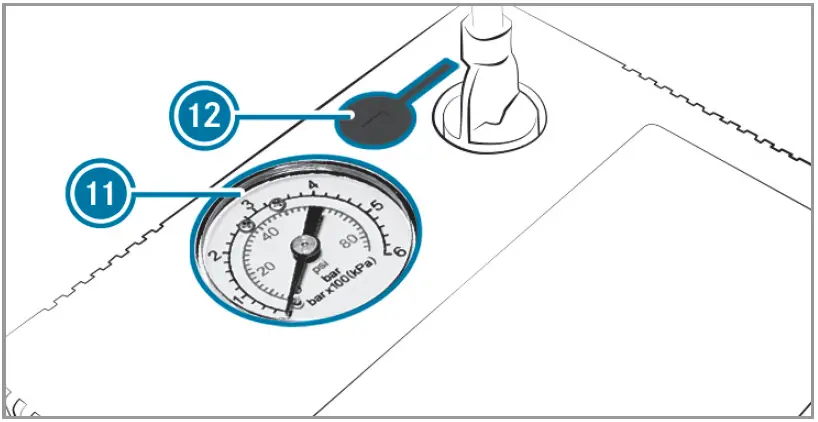
- Press pressure release button C next to manometer B.
When the tire pressure is correct
- Unscrew the filling hose from the valve of the sealed tire.
- Screw the valve cap onto the valve of the sealed tire.
- Store the tire sealant bottle and the tire inflation compressor.
- Drive to the nearest qualified specialist workshop and have the tire, tire sealant bottle, and filling hose replaced there.
Battery (vehicle)
Notes on the 12 V battery
WARNING
Risk of an accident due to work carried out incorrectly on the bat‐tery
Work carried out incorrectly on the battery can, for example, lead to a short circuit. This can restrict functions relevant for safety sys‐tems and impair the operating safety of your vehicle.
You could lose control of the vehicle in the following situations in particular:
- When braking
- In the event of abrupt steering maneuvers and/or when the vehicle’s speed is not adapted to the road conditions
- In the event of a short circuit or a simi‐lar incident, contact a qualified special‐ist workshop immediately.
- Do not drive on.
- Always have work on the battery carried out at a qualified specialist workshop.
- Further information on ABS
- Further information on ESP®
For safety reasons, Mercedes-Benz recommends that you only use batteries which have been tes‐ted and approved for your vehicle by Mercedes-Benz. These batteries provide increased impact protection to prevent vehicle occupants from suffering acid burns should the battery be dam‐aged in the event of an accident.
Electrostatic charge can ignite the highly explosive gas mixture in the battery.
To discharge any electrostatic charge that may have built up, touch the metal vehicle body before handling the bat‐tery.
The highly flammable gas mixture is created while the battery is charging and during starting assistance.
WARNING
Danger of chemical burns from the battery acid
Battery acid is caustic
- Avoid contact with the skin, eyes or clothing.
- Do not lean over the battery.
- Do not inhale battery gases.
- Keep children away from the battery.
- Immediately rinse battery acid off thoroughly with plenty of clean water and seek medical attention immediately.
ENVIRONMENTAL NOTE
Environmental damage due to improper disposal of bat‐teries
Batteries contain pollutants. It is illegal to dispose of them with the household rubbish.
Dispose of batteries in an environmentally responsible manner. Take discharged batteries to a qualified specialist workshop or to a collection point for used batteries.
If you have to disconnect the 12 V battery, con‐tact a qualified specialist workshop.Comply with safety notes and take protective measures when handling batteries.
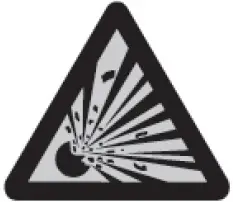 Risk of explosion.
Risk of explosion. Fire, open flames, and smoking are prohibited when handling the battery. Avoid creating sparks.
Fire, open flames, and smoking are prohibited when handling the battery. Avoid creating sparks.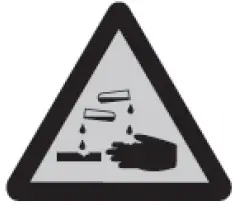 Electrolyte or battery acid is corrosive. Avoid contact with the skin, eyes or clothing. Wear suitable protective clothing, in particular gloves, an apron and a face mask. Immediately rinse electrolyte or acid splashes off with clean water. Consult a doctor if necessary.
Electrolyte or battery acid is corrosive. Avoid contact with the skin, eyes or clothing. Wear suitable protective clothing, in particular gloves, an apron and a face mask. Immediately rinse electrolyte or acid splashes off with clean water. Consult a doctor if necessary. Wear safety glasses.
Wear safety glasses. Keep children away.
Keep children away. Observe this Operator’s Manual.
Observe this Operator’s Manual.
If you do not intend to use the vehicle over an extended period of time:
- Activate standby mode, or
- Connect the battery to a battery charger approved by Mercedes-Benz, or
- Consult a qualified specialist workshop to disconnect the battery
Notes on starting assistance and charging the 12 V battery
When charging the battery and during starting assistance, always use the jump-start connec‐tion point in the engine compartment.
NOTE
Damage to the battery from over‐ voltage
When charging using a battery charger with‐out a maximum charging voltage, the battery or the on-board electronics may be damaged.
- Only use battery chargers with a maximum charging voltage of 14.8 V.
WARNING
Risk of explosion from hydro‐ gen gas igniting
There is a danger of hydrogen gas igniting when charging the battery if there is a short circuit or sparks start to form.
- Make sure that the positive terminal of the connected battery does not come into contact with vehicle parts.
- Never place metal objects or tools on a battery.
- The described order of the battery clamps must be observed when con‐necting and disconnecting the battery.
- When giving starting assistance, always make sure that you only connect bat‐tery terminals with identical polarity.
- During starting assistance, you must observe the described order for con‐necting and disconnecting the jumper cable.
- Do not connect or disconnect the bat‐tery clamps while the engine is running.
WARNING
Risk of explosion during charging process and starting assistance
During the charging process and starting assistance, the battery may release an explo‐sive gas mixture.
- Avoid fire, open flames, creating sparks and smoking.
- Make sure there is sufficient ventila‐tion.
- Do not lean over a battery.
WARNING
Risk of explosion from a frozen battery
A discharged battery may freeze at tempera‐tures slightly above or below freezing point.
During starting assistance or battery charg‐ing, battery gas can be released. Always allow a battery to thaw before charging it or performing starting assis‐tance.
If the indicator/warning lamps in the instrument cluster do not light up at low temperatures, it is very likely that the discharged battery has fro‐zen. In this case you may neither jump-start the vehicle nor charge the battery. The service life of a battery that has been thawed may be dramatically shortened. The starting characteristics may be impaired, espe‐cially at low temperatures.
It is recommended that you have a thawed bat‐tery checked at a qualified specialist workshop.
NOTE
Damage caused by numerous or extended attempts to start the engine
Numerous or extended attempts to start the engine may damage the catalytic converter due to non-combusted fuel.
Avoid numerous and extended attempts to start the engine.
Observe the following points during starting assistance and when charging the battery:
- Only use undamaged jumper cables/charging cables with a sufficient cross-section and insulated terminal clamps.
- Non-insulated parts of the terminal clamps must not come into contact with other metal parts while the jumper cable/charging cable is connected to the battery/jump-start con‐nection point.
- The jumper cable/charging cable must not come into contact with any parts which may move when the engine is running.
- Always make sure that neither you nor the battery is electrostatically charged.
- Keep away from fire and open flames.
- Do not lean over the battery.
Observe the additional following points when charging the battery:
- Only use battery chargers tested and approved for Mercedes-Benz.
- Read the battery charger’s operating instructions before charging the battery.
Observe the additional following points during starting assistance:
- For starting assistance, only use batteries with a nominal voltage of 12 V.
- The vehicles must not touch.
- Gasoline engines: Only accept starting assistance if the engine and exhaust system are cold.
Starting assistance and charging the 12 V battery
Requirements:
- The vehicle is secured with the electric parking brake.
- Automatic transmission: The transmission is in position j.
- The ignition and all electrical consumers are switched off.
- The hood is open.
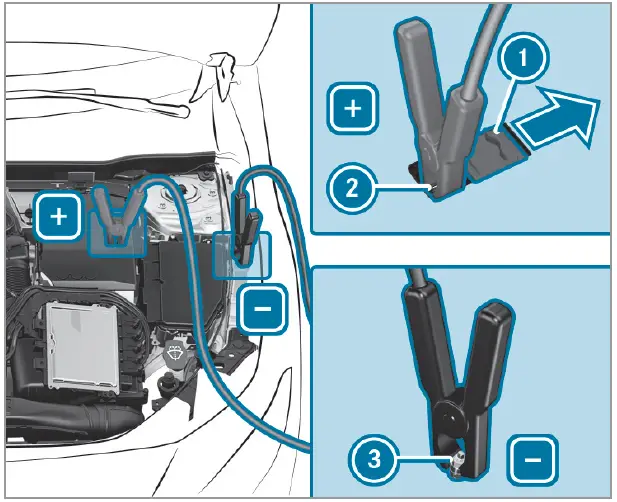
- Slide cover 1 of positive clamp 2 on the jump-starting connection point in the direction of the arrow.
- Connect positive clamp 2 on your vehicle to the positive pole of the donor battery using the jumper cable/charging cable. Always begin with positive clamp 2 on your own vehicle first.
- During starting assistance: start the engine of the donor vehicle and run at idle speed.
- Connect the negative pole of the donor battery and ground point 3 of your own vehicle by using the jumper cable/charging cable. Begin with the donor battery first.
- During starting assistance: start the engine of your own vehicle.
- During the charging process: start the charging process.
- During starting assistance: let the engines run for several minutes.
- During starting assistance: before disconnecting the jumper cable, switch on an elec‐trical consumer in your own vehicle, e.g. the rear window heater or lighting.
When the starting assistance/charging process is complete:
- First, remove the jumper cable/charging cable from ground point 3 and the negative pole of the donor battery, then from positive clamp 2 and the positive pole of the donor battery. Begin each time with the contacts on your own vehicle first.
- After removing the jumper cable/charging cable, close cover 1 of positive clamp 2.
Further information can be obtained at a qualified specialist workshop.
Replacing the 12 V battery
Observe the notes on the 12 V battery.
Mercedes-Benz recommends that you have the 12 V battery replaced at a qualified specialist workshop, e.g. at an authorized Mercedes-Benz Center.
Observe the following notes if you want to replace the battery yourself:
- Always replace a faulty battery with a battery that meets the specific vehicle requirements.
The vehicle is equipped with a fleece battery. Full vehicle functionality is only guaranteed with a fleece battery. For safety reasons, Mercedes-Benz recommends that you only use batteries that have been tested and approved for your vehicle by Mercedes-Benz. - Use detachable parts such as vent hoses, elbow fittings or terminal covers from the battery which is to be replaced.
- Make sure that the vent hose is always connected to the original opening on the side of the battery. Install any existing or supplied cell caps.
Otherwise, gases or battery acid could escape. - Make sure that detachable parts are reconnected in the same way.
FAQs
The 2021 Mercedes-Benz A-Class Sedan’s pricing range starts about $35,000 and can increase depending on trim options and optional amenities.
The A-Class Sedan has room for up to five passengers in luxury.
The 2.0-liter turbocharged four-cylinder engine that powers the 2021 A-Class Sedan normally makes about 188 horsepower.
The seven-speed dual-clutch automatic gearbox is standard on the A-Class Sedan.
The 2021 A-Class Sedan includes standard safety systems including blind-spot monitoring, lane-keeping assistance, automated emergency braking, and front collision warning.
Yes, some trim levels of the A-Class Sedan come with the option of 4MATIC all-wheel drive.
The Mercedes-Benz User Experience (MBUX) infotainment system, a 7-inch or 10.25-inch touchscreen, Apple CarPlay, Android Auto, and voice-activated commands are all standard features of the A-Class Sedan.
Depending on the engine and powertrain, the combined MPG (miles per gallon) for the 2021 A-Class Sedan ranges from 25 to 35.
The A-Class Sedan has a respectable-sized trunk with a capacity of about 13.1 cubic feet.
The A-Class Sedan does include a Driver Assistance Package that is optional and includes features like active steering assistance, adaptive cruise control, and traffic sign recognition.
Genuine leather or high-quality synthetic leather upholstery in a variety of colors are frequently seen inside the A-Class Sedan.
A panoramic sunroof is an option on select A-Class Sedan models, thus the answer is yes.
The standard limited warranty for the A-Class Sedan is 4 years/50,000 miles.
Depending on the engine and powertrain, the A-Class Sedan can go from 0 to 60 mph in around 6.2 seconds.
The engineering and dependability of Mercedes-Benz automobiles are well renowned. Although the A-Class Sedan is usually regarded as a dependable luxury vehicle, long-term reliability depends on routine maintenance.
Useful Links
Download Manuals: Owner’s Manuals | Mercedes-Benz USA
View Full Manual: Mercedes-Benz A-CLASS SEDAN 2021 User Manual


